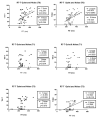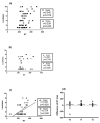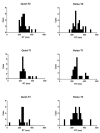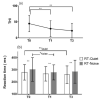The Impact of Acute Tinnitus on Listening Effort: A Study Based on Clinical Observations of Sudden Sensorineural Hearing Loss Patients
- PMID: 35329346
- PMCID: PMC8955353
- DOI: 10.3390/ijerph19063661
The Impact of Acute Tinnitus on Listening Effort: A Study Based on Clinical Observations of Sudden Sensorineural Hearing Loss Patients
Abstract
This study investigates the relationship between listening effort and acute tinnitus over the clinical course of sudden sensorineural hearing loss (SSNHL) before and after treatment. Thirty SSNHL patients with acute tinnitus were enrolled in this prospective study. Each patient was evaluated before treatment and after 1 and 3 months of follow-up. Listening effort was evaluated in the unaffected ears in two conditions (with and without background noise) using a dual-task paradigm, which included a primary (speech recognition) task and a secondary (visual reaction time) task. Tinnitus severity was assessed with the Tinnitus Handicap Inventory (THI). It was observed that background noise significantly increased listening effort in SSNHL patients with acute tinnitus before and after treatment. THI scores and listening effort in quiet conditions (** p = 0.009) were significantly decreased three months after treatment. In an analysis of the relation between tinnitus severity and listening effort, it was found that the THI total score was significantly correlated with listening effort in quiet (* p = 0.0388) and noisy conditions (* p = 0.044) before treatment. We concluded that SSNHL patients with acute tinnitus exerted greater listening effort in the presence of background noise than in quiet conditions. Furthermore, listening effort was reduced as tinnitus improved in SSNHL patients during the three months after treatment. Both before and after 3 months of treatment, patients who were more affected and emotionally distressed by tinnitus tended to exert more listening effort in both quiet and noisy environments.
Keywords: listening effort; sudden sensorineural hearing loss; tinnitus.
Conflict of interest statement
The authors declare no conflict of interest.
Figures









Similar articles
-
[Tinnitus assessment by THI and VAS in patients with sudden sensorineural hearing loss].Lin Chuang Er Bi Yan Hou Tou Jing Wai Ke Za Zhi. 2014 Nov;28(22):1777-9. Lin Chuang Er Bi Yan Hou Tou Jing Wai Ke Za Zhi. 2014. PMID: 25752112 Chinese.
-
Standard and Extend High-Frequency Audiometry in Sudden Sensorineural Hearing Loss: Impacts on Tinnitus and Mental Health.Otol Neurotol. 2024 Jun 1;45(5):e366-e375. doi: 10.1097/MAO.0000000000004168. Epub 2024 Mar 21. Otol Neurotol. 2024. PMID: 38511269
-
Prognostic and Evolutive Factors of Tinnitus Triggered by Sudden Sensorineural Hearing Loss.Otol Neurotol. 2016 Jul;37(6):627-33. doi: 10.1097/MAO.0000000000001049. Otol Neurotol. 2016. PMID: 27223675
-
Clinical management and progress in sudden sensorineural hearing loss during pregnancy.J Int Med Res. 2020 Feb;48(2):300060519870718. doi: 10.1177/0300060519870718. Epub 2019 Aug 27. J Int Med Res. 2020. PMID: 31452412 Free PMC article. Review.
-
Sudden Sensorineural Hearing Loss in Children-Management and Outcomes: A Meta-analysis.Laryngoscope. 2021 Feb;131(2):425-434. doi: 10.1002/lary.28829. Epub 2020 Jul 16. Laryngoscope. 2021. PMID: 32673420
Cited by
-
Investigation of the behavior of tinnitus patients under varying listening conditions with simultaneous electroencephalography and pupillometry.Brain Behav. 2024 Jun;14(6):e3571. doi: 10.1002/brb3.3571. Brain Behav. 2024. PMID: 38841736 Free PMC article.
-
Reaction Time in Fibromyalgia Patients.Curr Rheumatol Rev. 2024;20(5):514-521. doi: 10.2174/0115733971276641231201055731. Curr Rheumatol Rev. 2024. PMID: 38314594
-
Diagnostic and predictive values of serum metabolic profiles in sudden sensorineural hearing loss patients.Front Mol Biosci. 2022 Sep 6;9:982561. doi: 10.3389/fmolb.2022.982561. eCollection 2022. Front Mol Biosci. 2022. PMID: 36148011 Free PMC article.
-
Assessing the Effectiveness of Different Hyperbaric Oxygen Treatment Methods in Patients with Sudden Sensorineural Hearing Loss.Audiol Res. 2024 Mar 29;14(2):333-341. doi: 10.3390/audiolres14020029. Audiol Res. 2024. PMID: 38666900 Free PMC article.
-
Investigation of Listening Effort in Tinnitus Patients by Providing Similar Peripheral Auditory Function With Control Group.Brain Behav. 2025 Feb;15(2):e70306. doi: 10.1002/brb3.70306. Brain Behav. 2025. PMID: 39957087 Free PMC article.
References
-
- Hicks Candace B., Tharpe Anne M. Listening Effort and Fatigue in School-Age Children With and Without Hearing Loss. JSLHR. 2002;45:573–584. - PubMed
Publication types
MeSH terms
LinkOut - more resources
Full Text Sources
Medical

